What is the place, this name Mandalay I’ve heard so many times and know nothing about?
We arrived in Myanmar (formerly known as Burma) at the Mandalay airport, boarded a bus and endured a bumpy 45 mins drive to our hotel. Our hotel was quite nice but near the train station that was under regular construction. The trains occasionally trickled by, and like everything else that moves, they kick up the dust that coated the streets everywhere. All along the construction site a shanty town was built up with families cooking food over fires and young children running around half naked.
Mandalay is the biggest city in the northern half of Myanmar, with a population around 1.5 million, it feels big and small at the same time. It’s a sprawling city with large city blocks and few buildings above 15 stories. The haze of dust and smoke hangs suspended over the city, and I wonder if it’s always like this?
We kept seeing the same tourists here and there, but maybe that’s because tourism in Myanmar is somewhat restrictive. To receive a tourist visa you are required to find accommodation at a registered hotel, at least at first — so airbnb is not so popular.
Burmese
Like many places on our journey, everything seemed a little different at first, or at least surprisingly different from neighboring Thailand. There is a 30-min time difference — who does that? Most men where longyi (lon-jee), like sarongs for men just as we saw in Bali. The Burmese written language looks quite different from Thai, although it actually looks related to the old script language you see in some old Thai temples (Lanna script) — lots of circular characters.
Betel nut is chewed and spat everywhere. It stains the streets and sidewalks as well as people’s teeth. I’ve read that like nicotine it works like a mild stimulant and also is terrible for everything in your mouth. So I can imagine why it has been banned in some countries and discouraged in many others although there are exceptions made for traditional cultural practices. Because betel nut has a traditional connection to almost all cultures across Southeast Asia.
Another thing you will notice immediately are peoples faces covered with chalky beige paste. This is thanaka. For thousands of years the Burmese takes branches from thanaka trees, and rub cuts of it with water over a special grinding stone producing a paste to smear on the face — mostly cheeks and foreheads of women, girls and some young boys. Why? — it’s supposed to be a good sunblock and for a little while it offers a cooling sensation. We saw the thanaka wood cuts sold all over Myanmar, from local markets to streets vendors marketing to tourists.
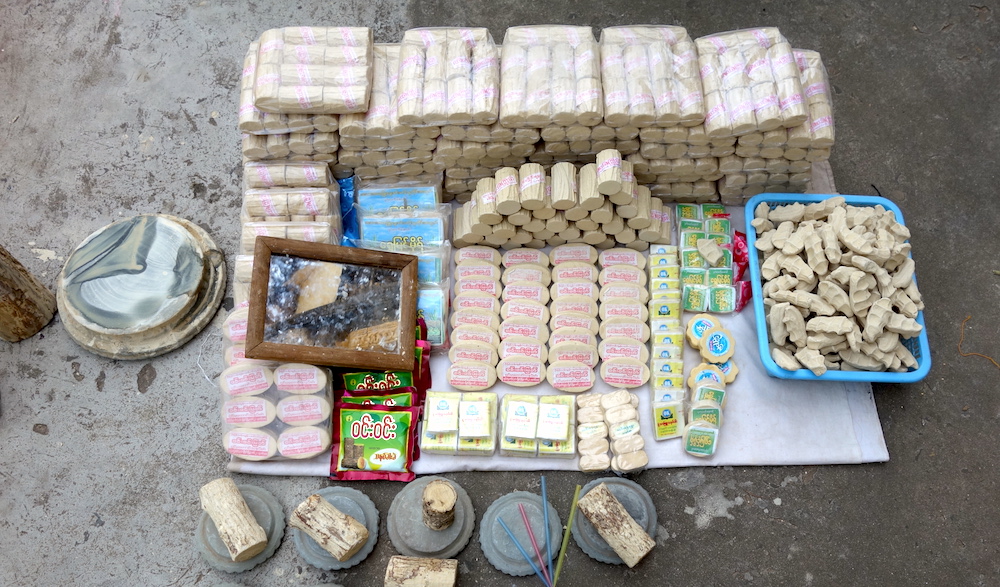 Various thanaka products
Various thanaka products
Mandalay Palace
In the northern area of Mandalay is the massive 2 square kilometer moat-lined citadel which houses Mandalay Palace. The palace, initially constructed in the mid-19th century, did not appear to be well maintained. That’s in part because only a few decades after it was built the British invaded, colonized Burma and repurposed the whole citadel as a military fort. Later during World War II the Japanese occupied the citadel as a supply depot and which meant it was target for allied bombing. Most of the palace was lost and only restoration efforts only began in 1989.
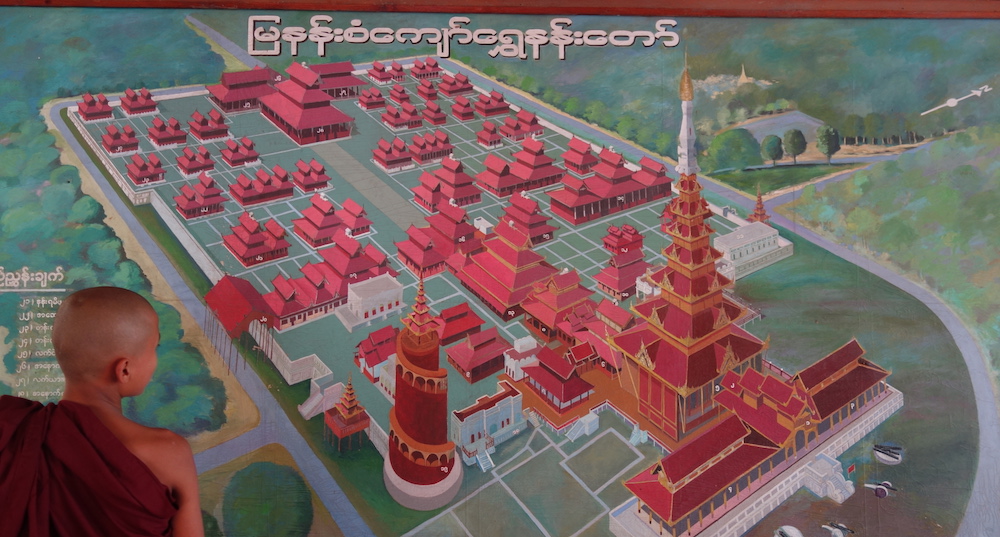 Diagram of Mandalay Palace
Diagram of Mandalay Palace
The compound grounds (the part within the moat but outside the inner palace grounds) is still protected for military functions and most of it is off limits. Though rebuilt with non-traditional materials, the palace had unique touches that referenced the styles of a mostly forgotten royal history in Myanmar.
 Mandalay Palace from the watch tower
Mandalay Palace from the watch tower
Min Kun
Take a boat a half hour ride from Mandalay up the Ayeyarwady River (or Irrawaddy) and you will see a enormous almost cubic stupa rising on the horizon. The stupa is located in Min Kun (or Mingun), a small town with a number of famous Buddhist monuments. The brick stupa was built in the late 18th century and if completed would have been the largest in the world. Since then it has suffered the effects of many large and small earthquakes leaving the stupa cracked and toppled in many places.
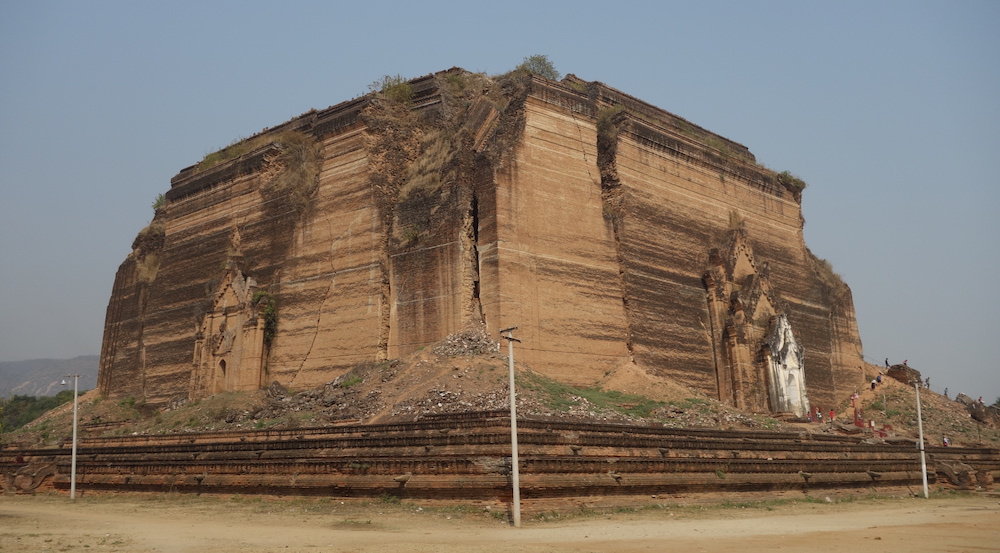 Minkun stupa
Minkun stupa
Min Kun is also known for having the largest functional working bell in the world. Standing in front of it you have no idea of this, since there was no sign visible to claim this title but we were informed by a very friendly guide that we hired for the hour or so that we roamed around the town. After the bell we visited some pagodas and before returning to the boat passed by two giant lion statues on the river front — also victims of the earthquakes the intended forms were fairly unrecognizable.
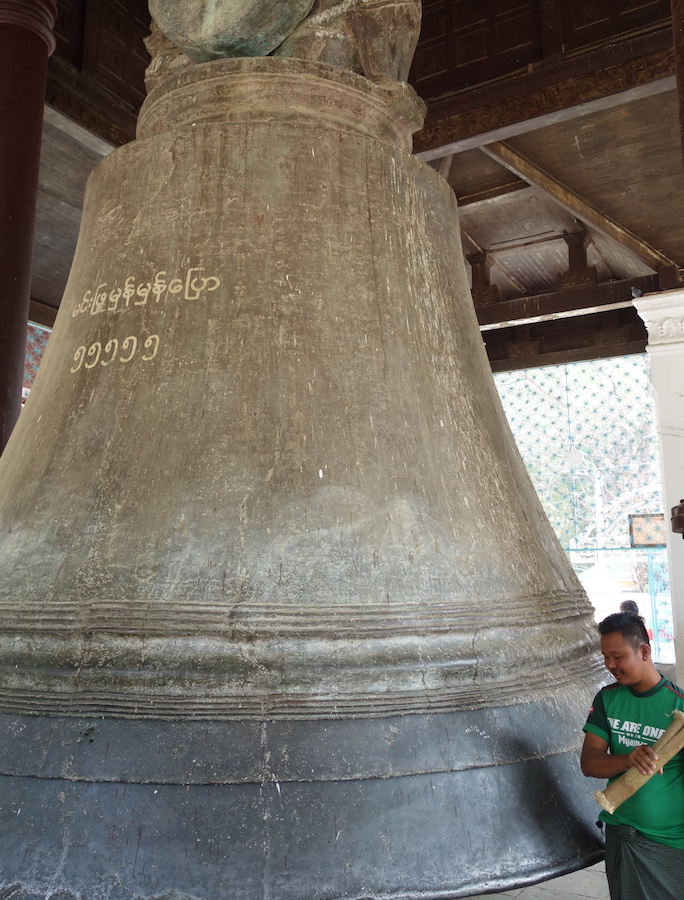 Minkun bell
Minkun bell
U Bein Bridge and Mandalay Hill
In the two weeks that we spent in the country we saw almost no clouds, few mountains and a handful of tall buildings, so we almost always had a clear view of the horizon for sunsets. But never once did we see the sun touch the horizon — before that it would always dim and fade away into the dusty haze. Still there some good sunset spots near Mandalay.
Mandalay Hill north of the city (the city is actually named after the hill) has historically had some important pagodas and monasteries making it an important pilgrimage site. We only went to the main temple site at the peak, Sutaungpyei Pagoda, to enjoy the sunset with the crowds.
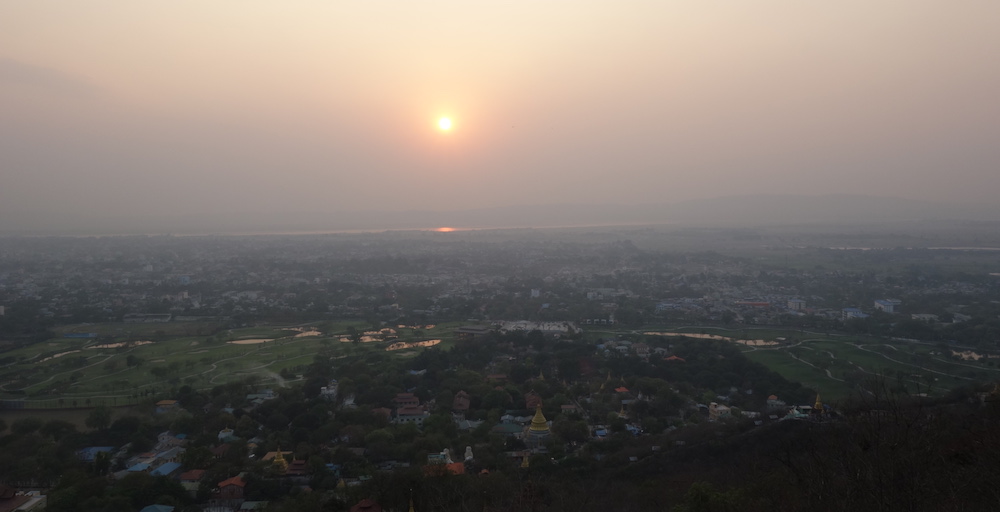 Sunset from Mandalay Hill
Sunset from Mandalay Hill
U Bein Bridge that spans a shallow (unless its rainy season) lake that connects Amarapura, a former royal capital of Myanmar, to the east, away from the floods of Ayeyarwady. The 1.2 km teak wood bridge attracts lots of visitors (foreign and local) and provided a picturesque setting to our last day in Mandalay before we took off for Bagan.
 U Bein Bridge
U Bein Bridge
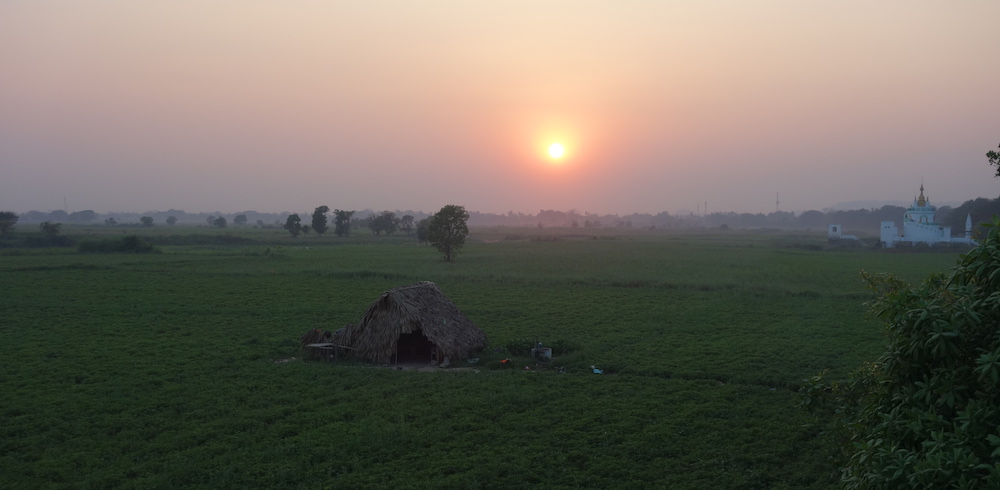 Sunset from U Bein Bridge
Sunset from U Bein Bridge
After Chiang Rai we returned to Chiang Mai looking to have some down time to get ready for our trip to Myanmar. First we spent a week east of the Old City, and then we spent a few days on the west side of Chiang Mai, closer to the airport.
Our east side stay was at a homey Airbnb 2-story two bedroom house on a quiet street. All to ourselves with a very stocked kitchen we did plenty of cooking and it was a taste of a “normal” life — or maybe normal Western lifestyle. We kept it pretty simple and didn’t do too much, mostly exploring some local spots, parks, river walks, a remote resort where you could pay to use the pool. Then we packed up and moved to the next spot.
Rajapruek
Actually before we went to Chiang Rai, we had spent a week in the western part of Chiang Mai, between the mountains and the airport. During that stay we learned about the nearby Royal Park Rajapruek. The park has a simple hotel on one side, and if you stay there you get free tickets to the park. So that’s where we spent a few days.
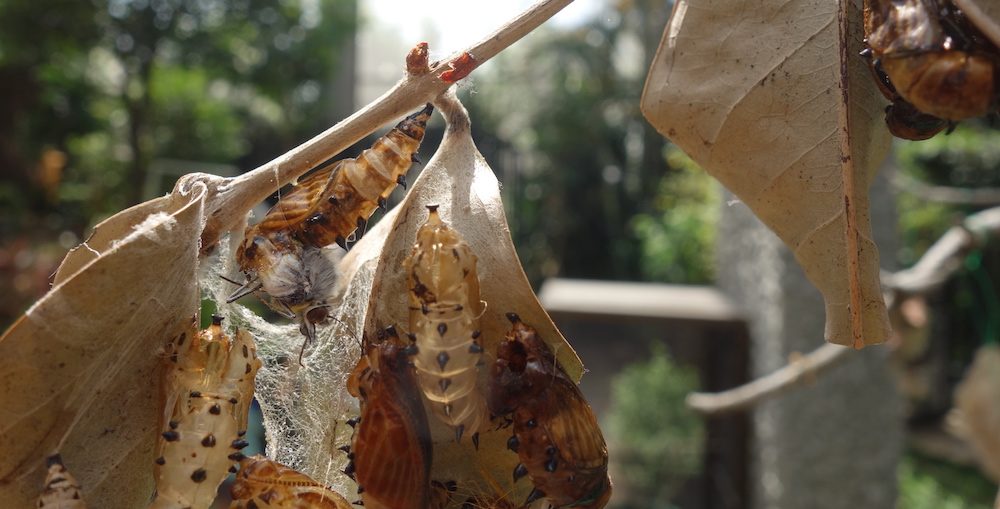 Coming out of cocoons in the bug exhibit
Coming out of cocoons in the bug exhibit
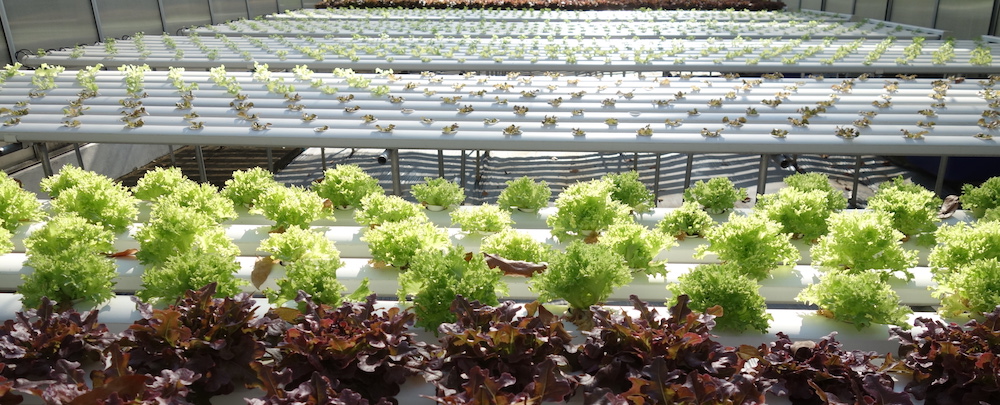 Hydroponics in a greenhouse
Hydroponics in a greenhouse
It’s a very large park (~200 acres), and doesn’t seem to be widely known because it’s a bit far from central Chiang Mai. Part of it is much like a botanical garden, with flower gardens (a famous orchid garden, this is the main reason people come to Rajapruek), a giant heirloom tomato trellis tunnel, and lot of stuff for curious kids. There also lots of agricultural projects nearby, and some of that is sold at their on-site produce store.
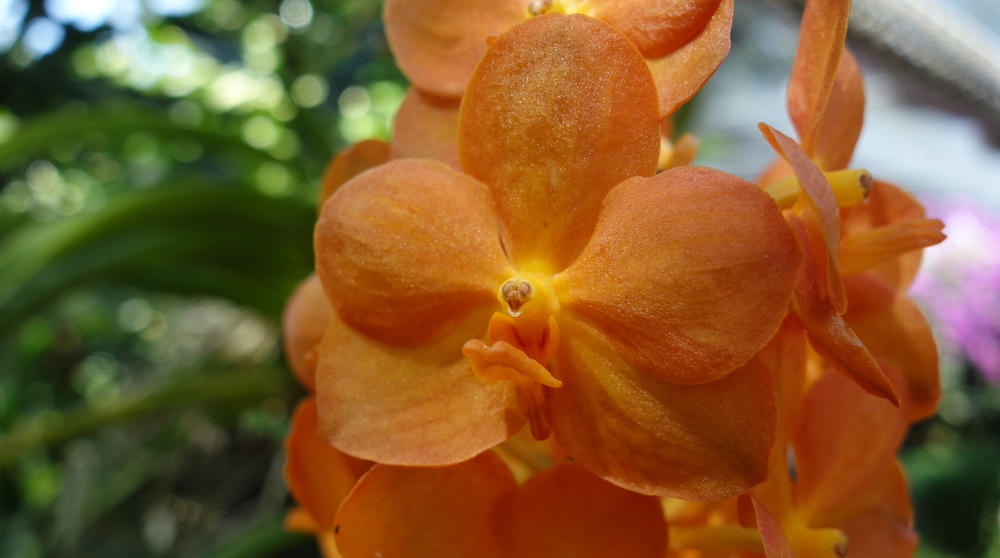 Beauties in the orchid garden
Beauties in the orchid garden
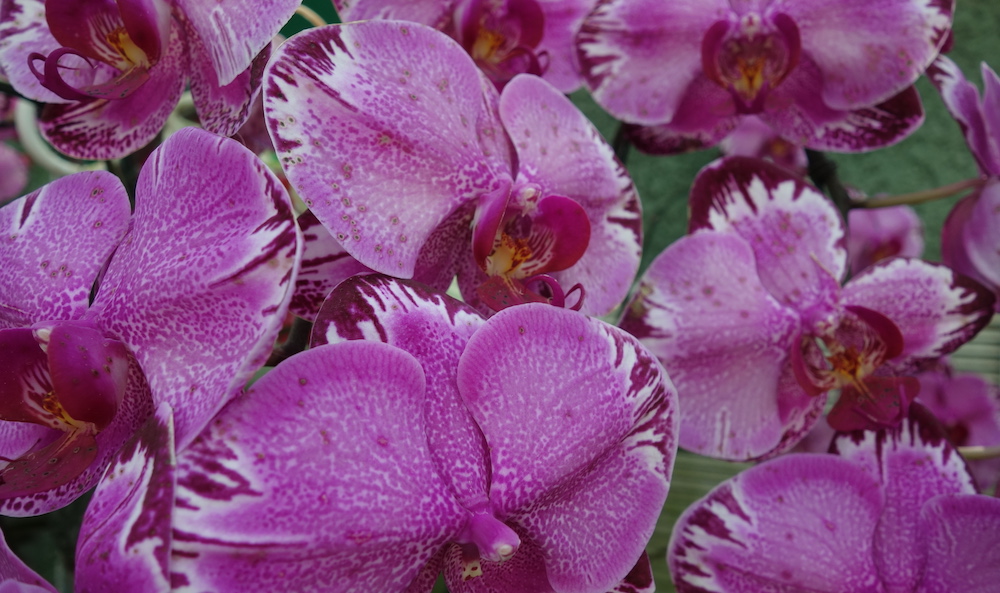 More orchids
More orchids
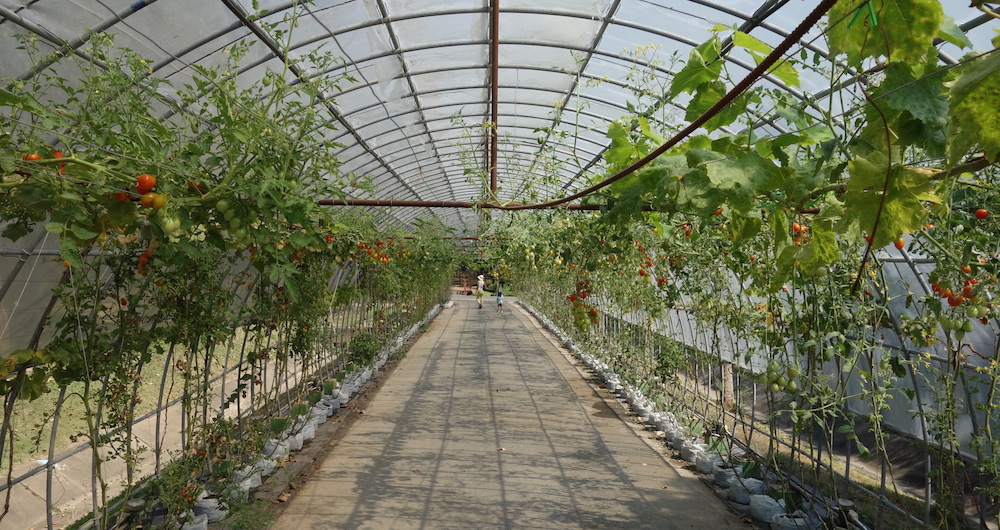 Tomato tunnel
Tomato tunnel
The gardens also have an international pavilion. These are a collection of self-contained gardens, each one created in the style of (or inspired by) a country — Kenya, Myanmar, Vietnam, China, Qatar, etc. — about 30 altogether. These mini gardens serve as a prelude to the large royal Thai pavilion, a reminder that the entire park was built in the honor of (now deceased) king in 2006.
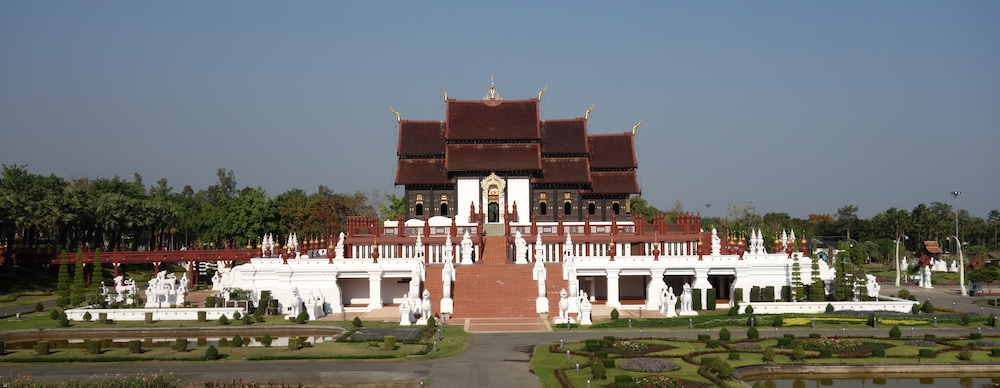 Royal Pavilion (exterior)
Royal Pavilion (exterior)
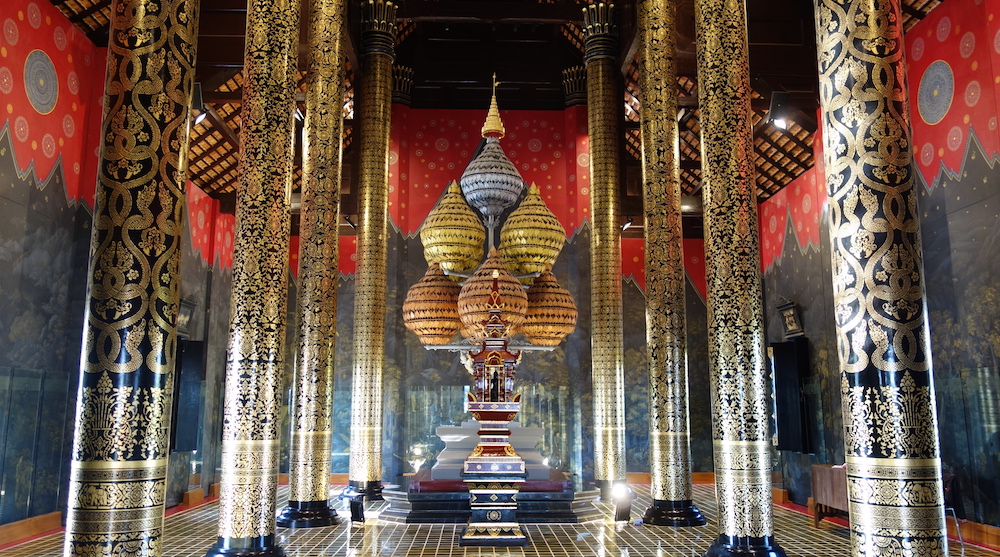 Royal Pavilion (interior)
Royal Pavilion (interior)
Back to Thailand
After leaving Da Lat, we had a brief stay in Ho Chi Minh City and then flew to Chiang Mai. After some intense experiences in Vietnam it was refreshing to be back in the familiar space of northern Thailand. I’ve already written of Chiang Mai, and I will get to it again in the next post, but I wanted to skip to Chiang Rai.
Chiang Rai
Before coming to Thailand I had this notion that Chiang Mai and Chiang Rai were close sister cities — I think that’s just because the names sound similar. But of course, that notion is nonsense. Chiang Rai is very much its own place, reachable within a few hours bus ride from Chiang Mai. Compared to Chiang Mai it feels much smaller and quieter, but with a lot of charm if you look around.
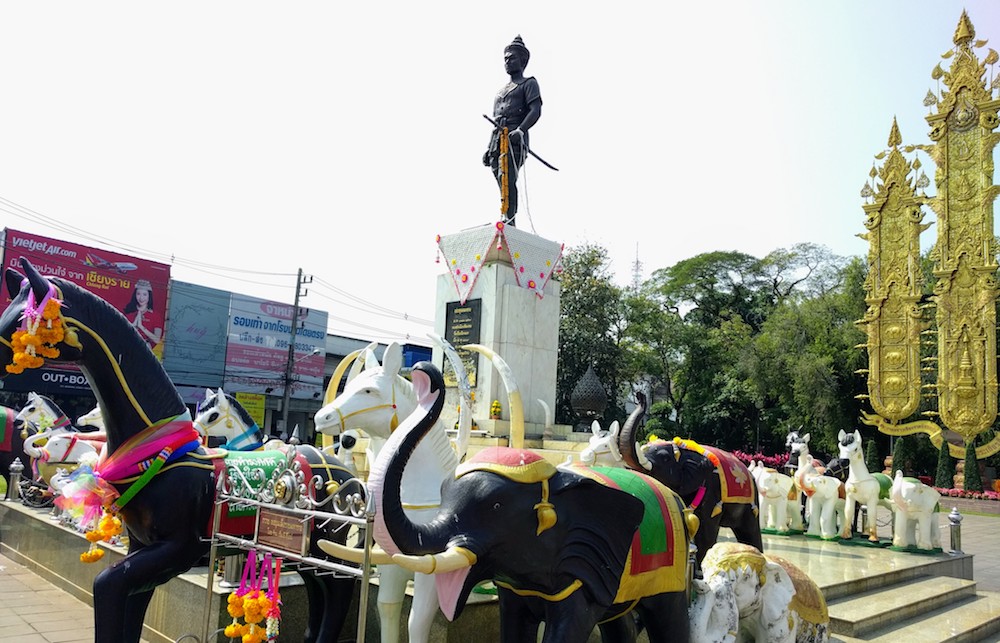 King’s Monument
King’s Monument
It also helped that we stayed in a homestay run by two super friendly guys who cooked amazing breakfasts for us every morning. Best pad thai imaginable.
Temple Run
On motorbike we explored a fair amount in and around the city. Chiang Rai is well known for its interesting temples — what’s interesting is many are surprisingly unconventional.
Wat Phra Kaew is a good example of the Chiang Rai’s traditional and historical temples. In the 15th century the temple’s already ancient stupa was struck by lightning which revealed a sacred green stone (emerald) Buddha statue — or so the story goes. Also, because it is a royal temple with regular donations it has a decent museum on the grounds.
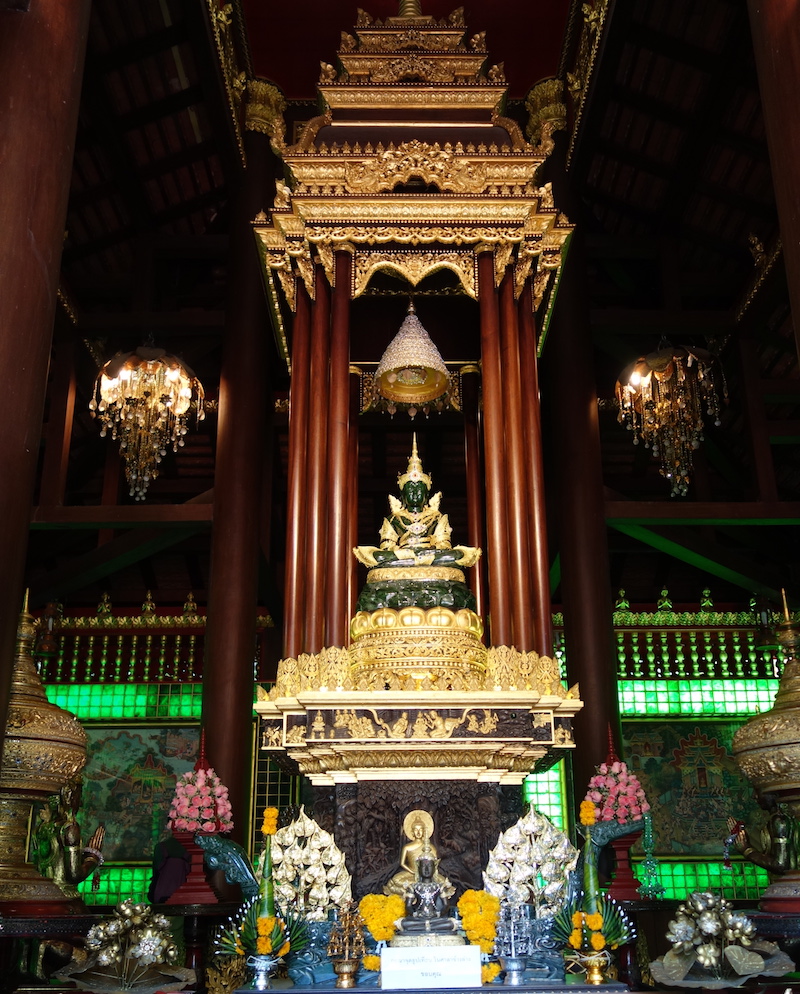 Emerald statue at Wat Phra Kaew
Emerald statue at Wat Phra Kaew
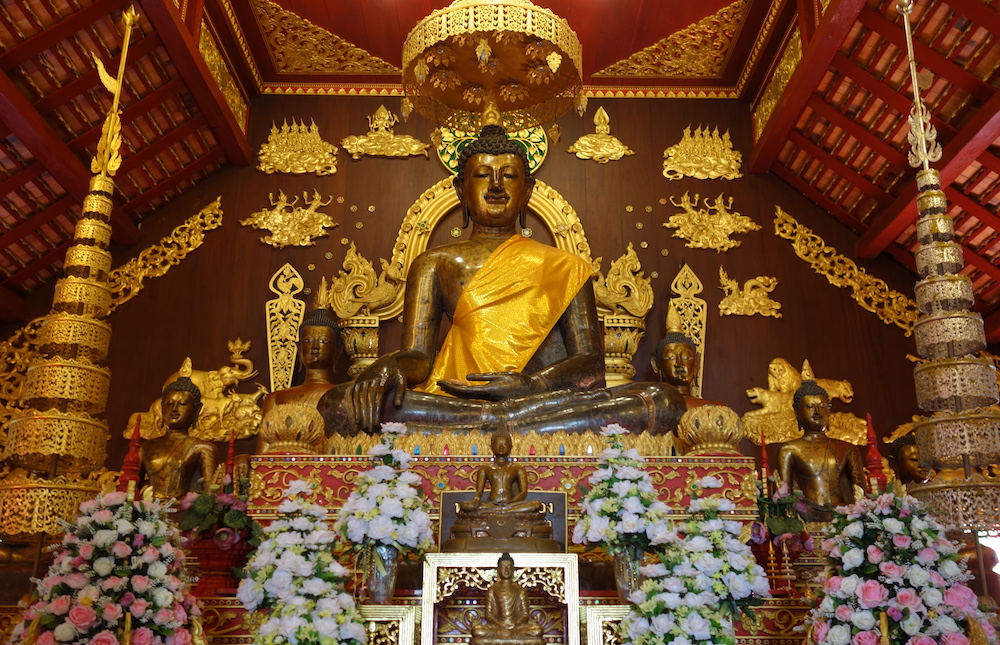 Wat Phra Kaew main temple
Wat Phra Kaew main temple
Wat Rong Khun, also known as the “White Temple“. Technically not a temple, but actually an art exhibit that attracts a huge number of tourists. Apparently it used be a real temple but was built (or rebuilt to some extent) by a local artist with curious artistic add-ons, and statues. Though almost all in bright bleached white, it all felt a bit gaudy and so only faintly connected with the Buddhist practices or storytelling.
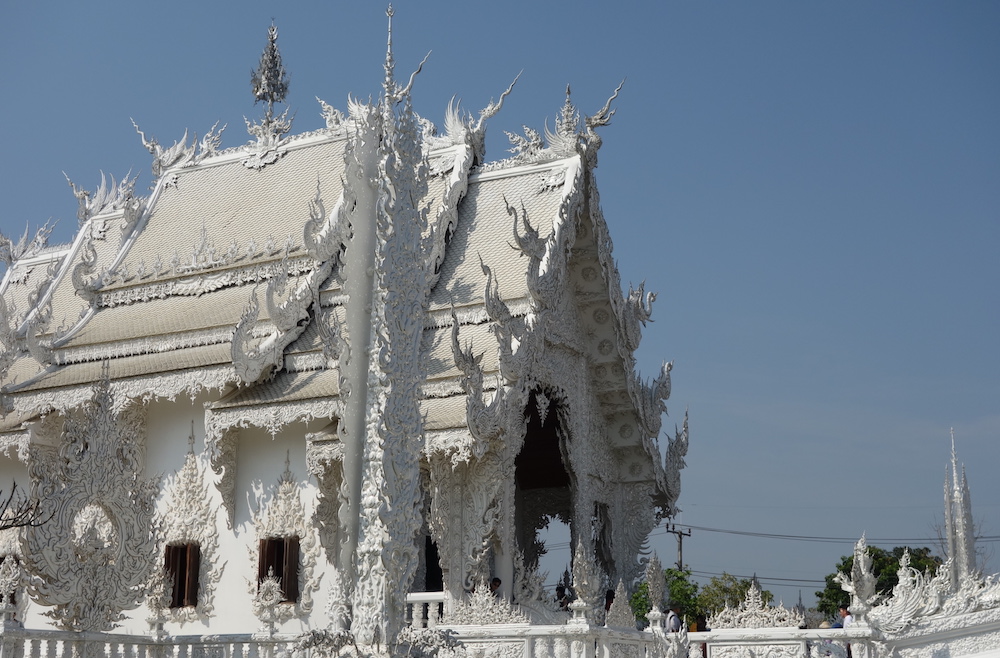 Wat Rong Khun
Wat Rong Khun
And then by contrast (at least in color) there is Wat Rong Suea Ten, known commonly as the Blue Temple. Built on top of ancient temple ruins, construction for this temple was finished only recently. Inside the main hall there are collection fantastical murals, all in a bright blue theme, that clearly depart from traditional Thai styles. Though it is a true religious temple it’s hard to imagine it being used that way considering it was stuffed with gawking tourists.
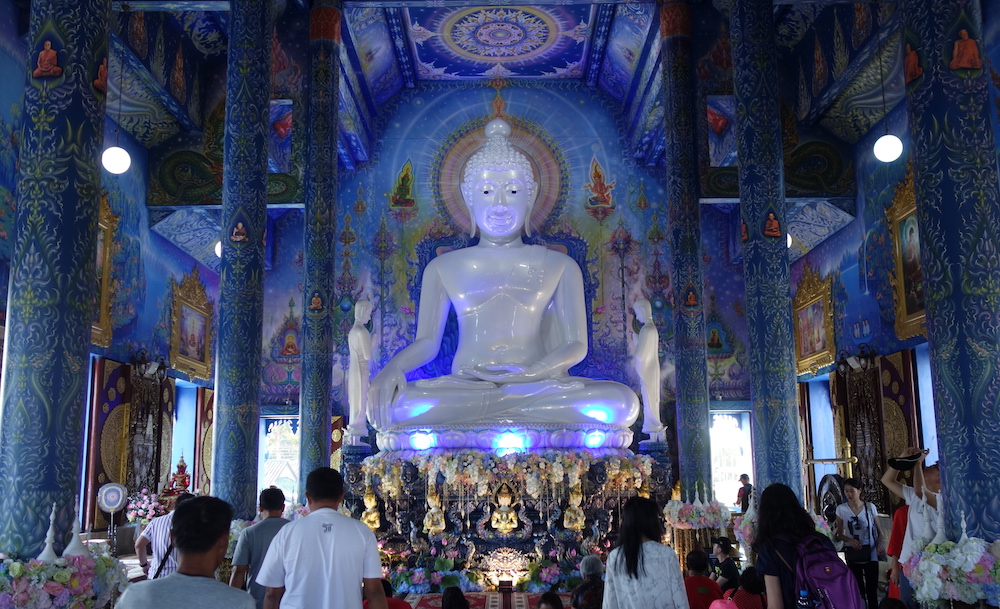 Wat Rong Suea Ten
Wat Rong Suea Ten
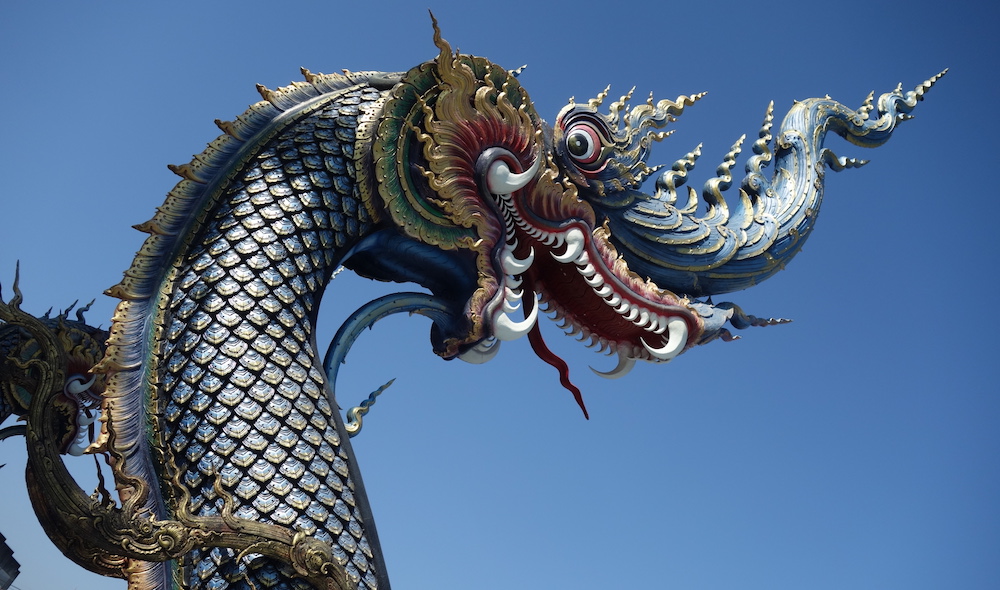 Dragon statue at Wat Rong Suea Ten
Dragon statue at Wat Rong Suea Ten
And if you’re looking for more colorized themes, there is also Baan Dam, or “Black House”, another art exhibit which we didn’t visit. But this one is also popular stop for travelers. I wonder if there are more colorful sites in the works.
Hot Things
Our exploration north of Chiang Rai led us to a fascinating handmade pottery workshop with some impressive pieces made with local clays. Unfortunately we didn’t get a good look at their firing kilns, but it looks like some of them might have been wood fire kilns.
Also, especially significant (and relieving) to Kanako was a small hot spring establishment. The hot spring had an outdoor foot bath and pool for those with swim suits, but also private indoor baths which worked well for us. They were just simple tiled cylindrical tubs with a spout for intensely hot water and another for cold. Eventually we got the temperature mix right and melted in the soothing spring water.
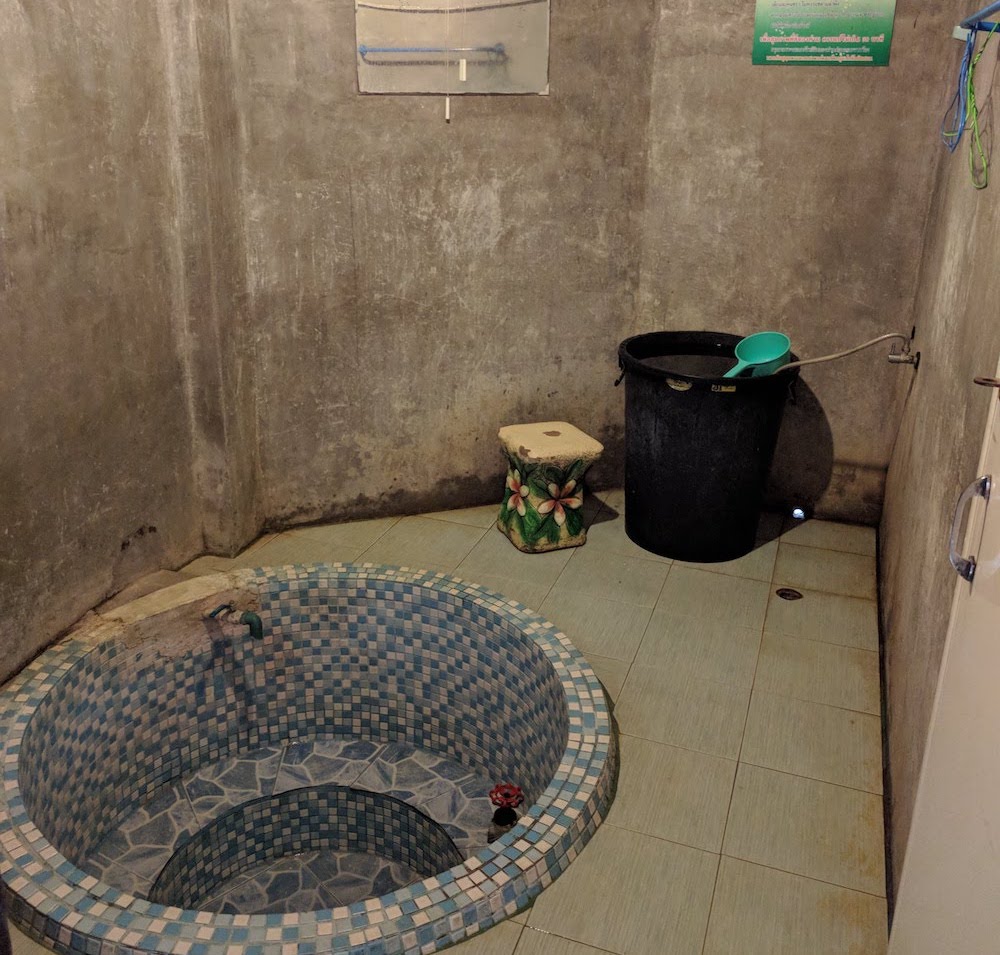 Bath at the hot springs
Bath at the hot springs
We just happened to be in Chiang Rai for the hot air balloon festival. So, near the end of our stay in Chiang Rai, we took a long ride one evening out to Singha Park (owned by Singha Brewing — the beer with the mythological lion on it) for the balloons. It was the first time any of us had seen hot air balloons so close, and it was a marvel just to watch them float carefully controlled through the air. There was actually a small game setup over a pond for the balloon teams to compete by dropping bean bags on bullseyes or through rings. It was amazing to see most of them deftly maneuver up and down gentle as clouds gliding through on calm day.
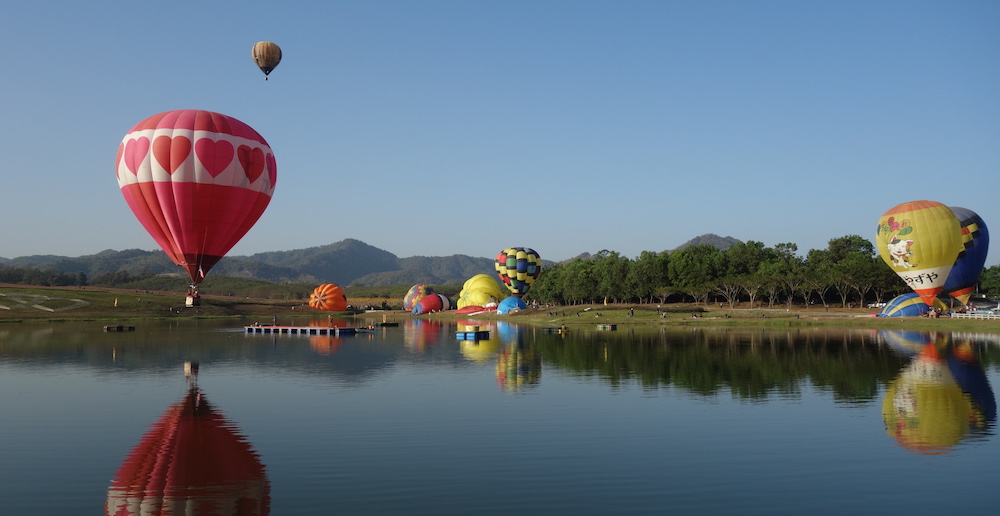 Hot air balloons at Singha Park
Hot air balloons at Singha Park
It seems Singha park is also known for its hills of cosmos flower (Cosmos bipinnatus), which were in full bloom and marvelous in the dusk light.
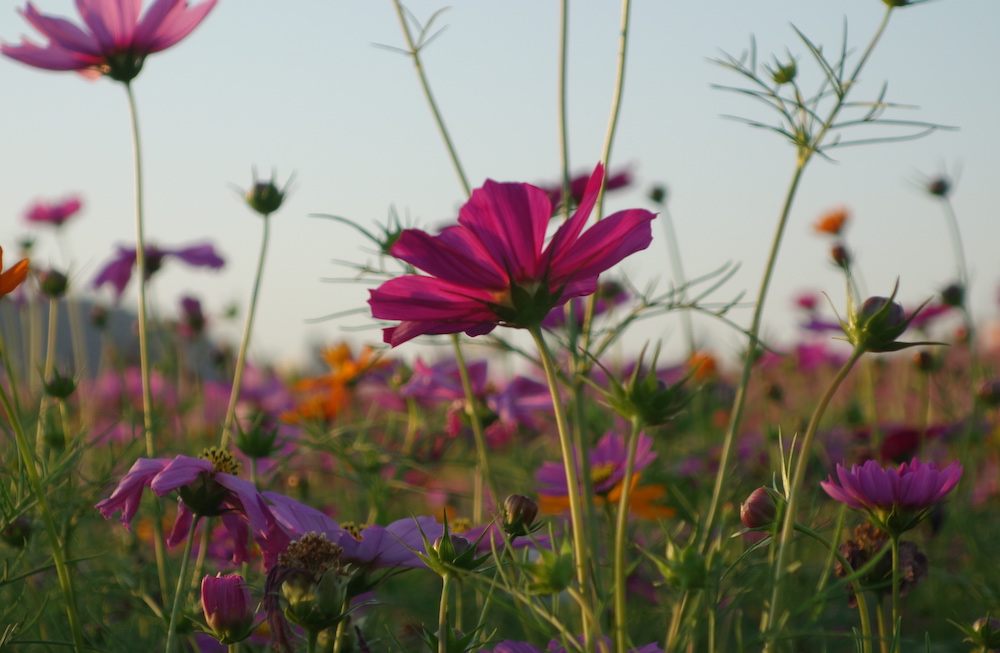 Cosmos
Cosmos
Sleeper Bus
From Ho Chi Minh City to Đà Lạt you can either fly or take a sleeper bus. We decided to the sleeper bus on the way there and then fly back. In Vietnam you will see sleeper buses all over the place, flying down the highway with bright colored LED lights and camped out at bus depots. They all seem pretty similar, built as double decker buses with three seats per row and two super narrow aisles, most have no bathroom. So in spite of the lack of bathroom these would be great sleeper buses for soccer team of 10 year olds. But if you are taller than 5 feet then there’s just no way you can fit in the reclined seat with your feet sticking out and sleep comfortably. We opted for the three seats all the way in the back on the first level and I managed to get maybe an hour of sleep in a diagonally-faced fetal position. I was not a happy camper. But Asa and Kanako did better. We left at 10:30 and it was supposed to take about 7 hours. Instead it took 5.5 hours so we arrived and were abruptly woken at 4am. Ushered into a shuttle bus that dropped us at our hotel where the hotel staff quite graciously allowed us to crash in a room for the rest of the morning.
Highland Life
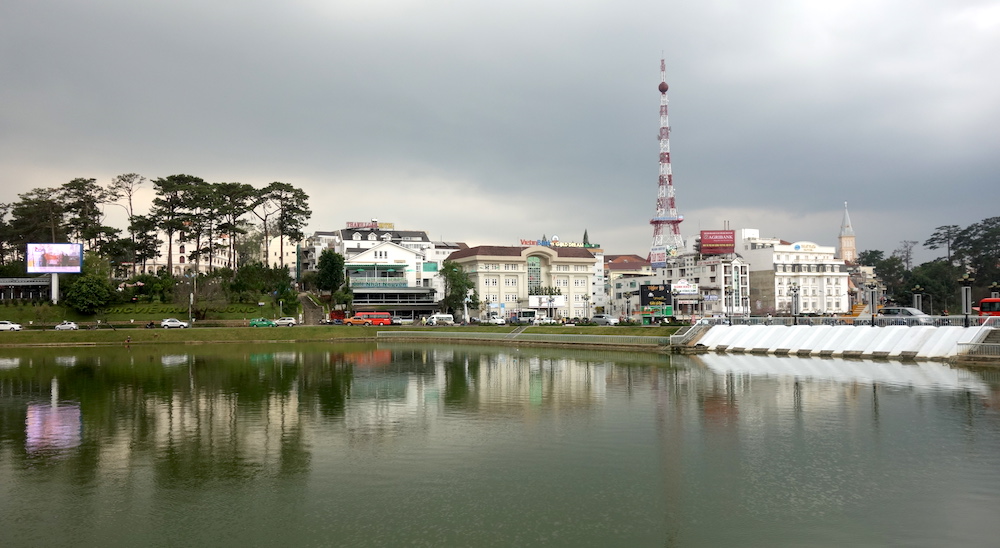 Along the lake in Da Lat town
Along the lake in Da Lat town
Da Lat or Dalat or Đà Lạt is a small and pleasant town in the highlands of southern Vietnam. The high terrain keeps the weather cool and makes for an ideal climate for growing lots of high value agriculture: tea, coffee, artichokes and gazillions of strawberries. The strawberries and lots of other products are grown in the truly endless corrugated waves of greenhouses that populate the hills everywhere outside of the main town.
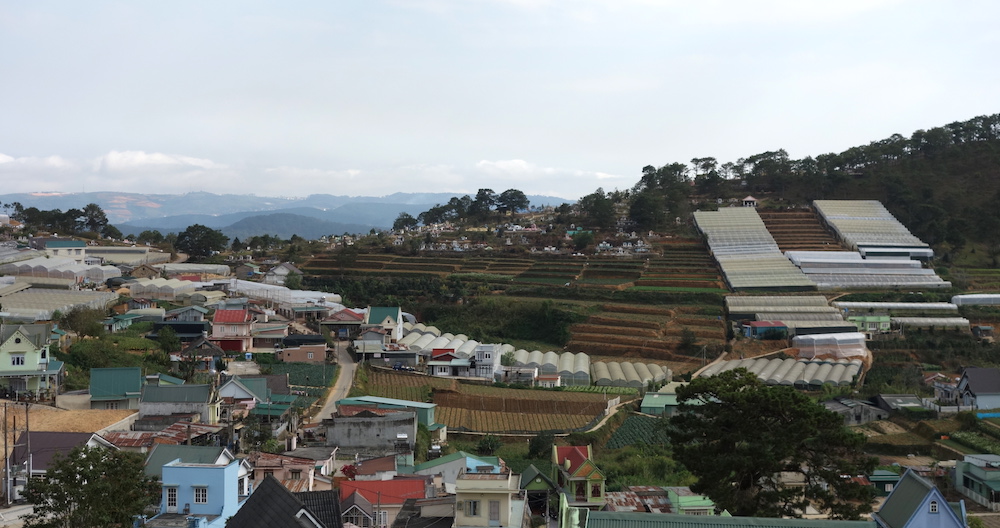 Greenhouses outside town
Greenhouses outside town
Like in, Ho Chi Minh City there were coffeeshops everywhere and the occasional tea shop, for tourists, connoisseurs or just simple tastes. We found some good places for local food; pho (noodle soup), banh bao (steamed bun), banh mi (sandwiches with egg, pate or grilled meat)
 Vietnamese coffee
Vietnamese coffee
Sights; Historical and Otherwise
The sights in Da Lat were a little more amusing than amazing, but we had fun.
There is the “Crazy House” (also known as the Hằng Nga Guesthouse), which is a dizzying network of architectural fantasy and insanity, with inspirations from Gaudi and Dali.
 Crazy House
Crazy House
There is the Bao Dai Summer Palace. Bảo Đại was the last feudal king of Vietnam part of the Nguyen Dynasty. Bao Dai’s rule was in the early part of the 20th century until Ho Chi Minh convinced him to abdicate the throne in 1945, but remained with some advisory rule to the newly formed Democratic Republic of Vietnam.
The picturesque Trúc Lâm Temple (Thiền Viện Trúc Lâm) was reachable by a 10-minute cable car ride over rolling pine tree hills. It’s a shame we didn’t have more time to explore much of the temple area. Many places close for lunch time in Vietnam (siesta style) – so we had to rush to leave before the cable car crew took off for lunch But the temple site was an impressive setting that reminded us of temples in Japan.
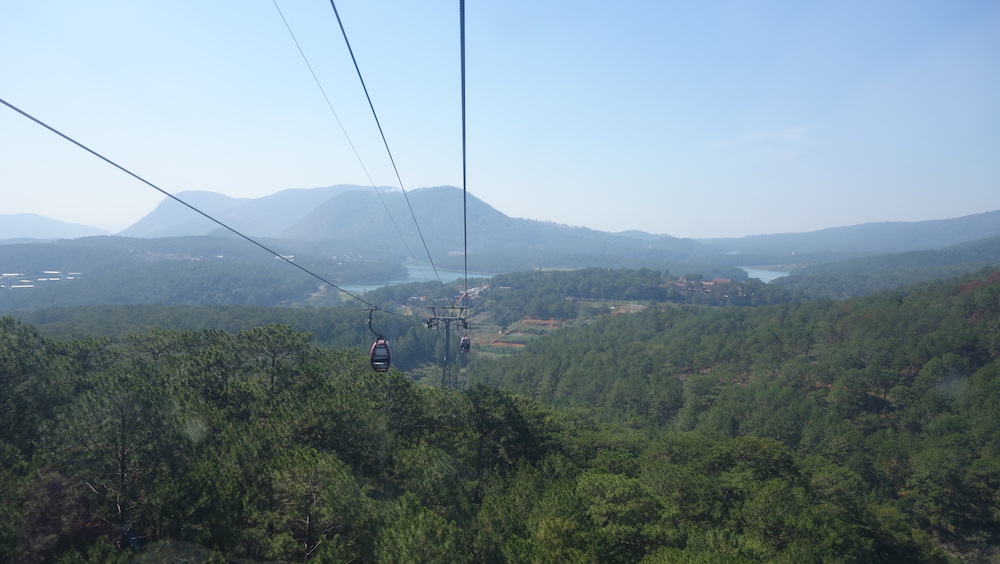 Cable car ride to Trúc Lâm Temple
Cable car ride to Trúc Lâm Temple